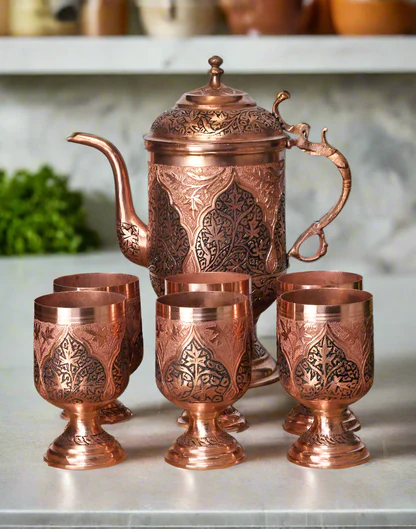
Copperware craftsmanship has been an integral part of Kashmir’s cultural tapestry for centuries. Renowned for its intricate designs, craftsmanship, and timeless appeal, Kashmiri copperware has earned a revered place in traditional households, and today, it continues to captivate people around the globe. Let’s explore the beauty and legacy of this craft.
Table of Contents
The History of Copperware in Kashmir
Copperware in Kashmir has a rich history that spans centuries, deeply intertwined with the region’s cultural, artistic, and economic evolution. The story of coppercraft in Kashmir is one of adaptation, artistic mastery, and resilience, influenced by diverse dynasties, religious traditions, and foreign influences, especially from Persia.
Early Beginnings and Indigenous Craftsmanship
The history of copperware in Kashmir can be traced back to ancient times, with evidence suggesting that metalworking existed in the region as early as the 8th century during the reign of Lalitaditya Muktapida, a renowned ruler of the Karkota dynasty. Under his reign, Kashmir was a center of art and culture, and its craftsmen were known for their exceptional skills in various forms of metalworking, including brass, gold, and copper. These early Kashmiri artisans were revered for their detailed work on temple art, statues, and utensils. Their craftsmanship, in bronze and copper, found its way to other regions, including Tibet and Central Asia.
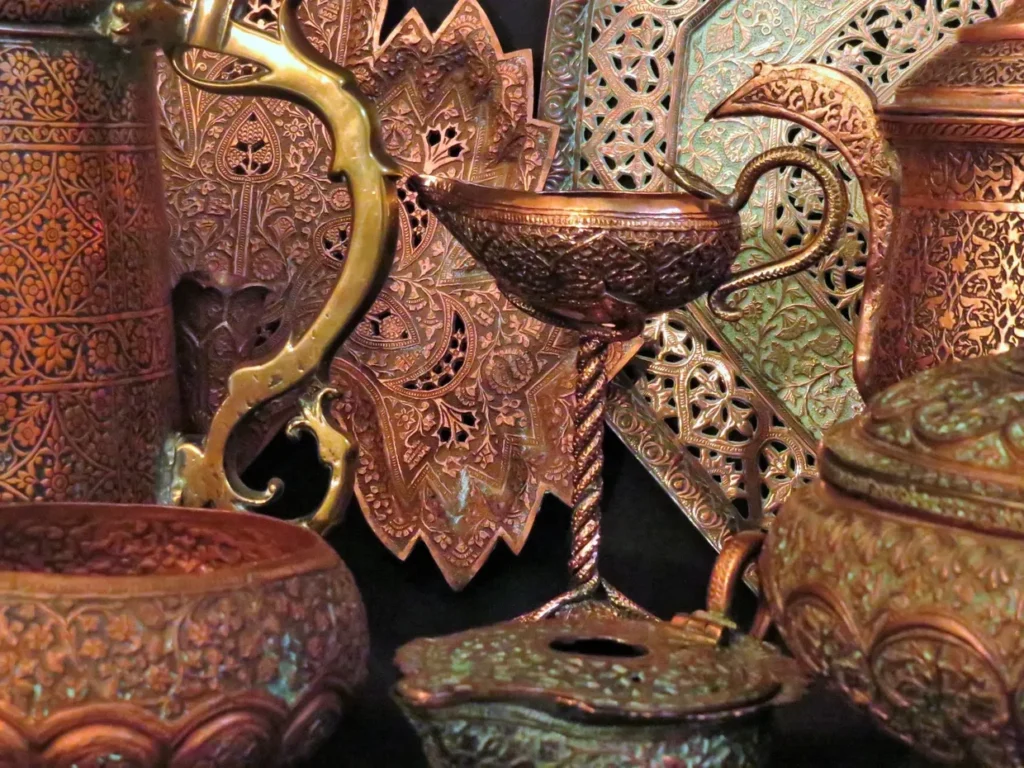
photo/thecashmerechronicles
Copper, mined from the mountains of Kashmir, was transformed into beautiful utilitarian objects, such as cooking pots and religious artifacts, which were used by the local population. These early creations displayed intricate craftsmanship, often incorporating local motifs, such as Chinar leaves and almond-shaped paisley patterns, that are still seen today.
The Persian Influence: 14th Century and Beyond
The 14th century marked a significant turning point for copperware in Kashmir. This was the era of Zain-ul-Abidin, the beloved Sultan of Kashmir, often referred to as the “Badshah” (The Great King). His reign was pivotal for the development of Kashmiri arts and crafts, particularly copperware. Zain-ul-Abidin invited skilled Persian artisans to Kashmir, many of whom brought with them new techniques and designs, particularly in copper and metalwork.
It was during this time that the famous samovar (a traditional tea kettle) made its appearance, an enduring symbol of Kashmiri craftsmanship. The samovar became a popular household item in Kashmir and continues to be an iconic copperware product associated with the region today. The fusion of local craftsmanship with Persian influences resulted in a unique style of copperwork that combined Indo-Persian motifs, such as geometric patterns and calligraphy, with Kashmiri designs like the Chinar leaf.
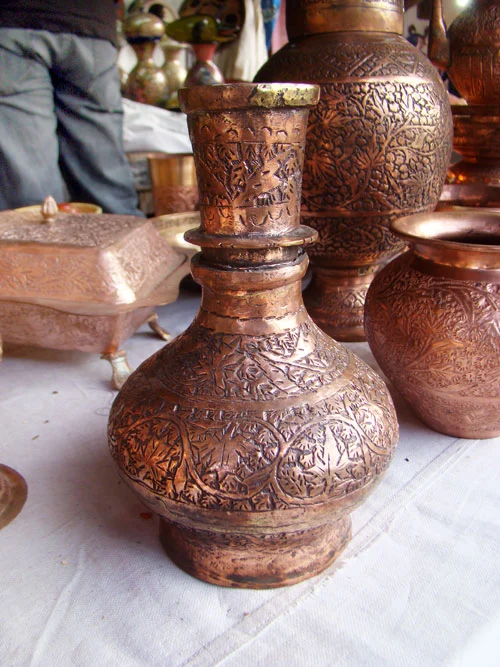
photo/camelcraft
Mughal and Post-Mughal Periods
During the Mughal era, which began in the 16th century, copperware production in Kashmir flourished further under the patronage of the Mughal emperors, especially Akbar and Jahangir. The Mughals appreciated Kashmiri craftsmanship and promoted the production of fine copper and brass items, which were adorned with intricate Meenakari (enamel work). While copper vessels and utensils were widely produced, the focus of metalworking in the Mughal period extended to the creation of weapons, including beautifully crafted swords, gun barrels, and shields.
The decline of the Mughal Empire by the 18th century saw a shift back to more utilitarian copperware, as the region grappled with political instability. The focus of artisans once again turned to household items, such as pots, trays, water jugs, and plates. Copper, which had long been a part of daily life in Kashmiri homes, became a symbol of both utility and tradition.

photo/kashmirbox
Colonial Era and the Industrial Impact
By the 19th century, during British colonial rule, Kashmir’s copperware craft began facing new challenges. The rise of mass-produced goods, facilitated by industrialization, started to overshadow traditional handmade crafts. The introduction of cheaper, machine-made alternatives from other regions put immense pressure on Kashmiri artisans, and the demand for handmade copperware declined. Despite this, Kashmiri copperware survived, largely due to the continued cultural significance of the craft within the region and the demand for its use in traditional Kashmiri ceremonies and households.
During this period, Kashmiri copperware became an essential part of weddings and other family events, where intricately designed copper plates, cups, and trays were passed down through generations as family heirlooms. These items were often personalized with names etched onto them, a practice that remains alive today.
The 20th Century: Revival and Challenges
The early 20th century witnessed a revival of copperware craftsmanship in Kashmir. This resurgence was driven by a renewed appreciation for handmade, artisanal goods in a world increasingly dominated by industrialization. Copperware artisans continued to create their distinctive works, often focusing on highly decorative items for tourists and collectors.
However, the tumultuous political history of Kashmir throughout the 20th century—marked by conflicts, curfews, and economic instability—created significant challenges for the craft. Many artisans found it difficult to sustain their work as access to raw materials and markets became more challenging. Despite these obstacles, the craft persevered, with some artisans continuing to produce copperware for local use and the tourism sector.
Why Copperware is Special
What makes copperware so captivating? For starters, copper has unique properties that make it valuable for both decorative and practical use. Copper’s natural antimicrobial properties make it a healthier choice for kitchenware. Using copper utensils, some say, can even purify water, which explains why it’s been a staple in Indian homes for centuries.
But beyond health benefits, copperware simply looks stunning. The warm, rich hues of the metal combined with the intricate engravings (called Naqashi) elevate it into a true work of art. Who wouldn’t want to add a dash of elegance to their kitchen or living room with a piece of beautifully crafted copperware?
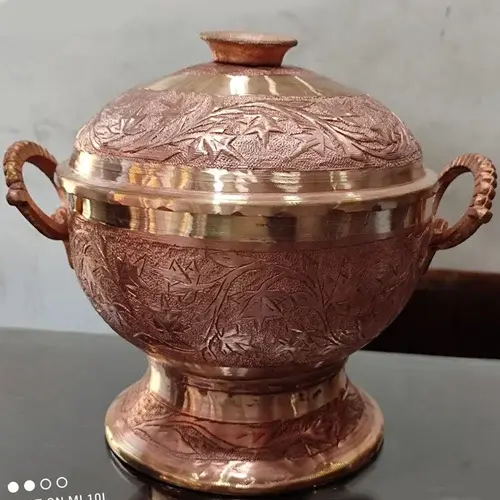
photo/indiamart
Also Read – India-Kashmir: Discover the Beauty of Paper Mache Craftsmanship
Craftsmanship Through the Ages
The art of Kashmiri copperware dates back to the 8th century during the reign of Lalitaditya, a period when Kashmiri craftsmen were celebrated for their intricate designs in metal. These craftsmen were not merely shaping copper; they were shaping history, with their work found in temples, monasteries, and even in far-flung lands like Central Asia and Tibet.
By the 14th century, Persian artisans brought back techniques to Kashmir, ushering in new innovations in copper craftsmanship. Noor, in his daydreams, imagined himself witnessing the evolution of Kashmiri copperware, from its humble origins to the introduction of the Samovar, a vessel that would become a symbol of the craft.
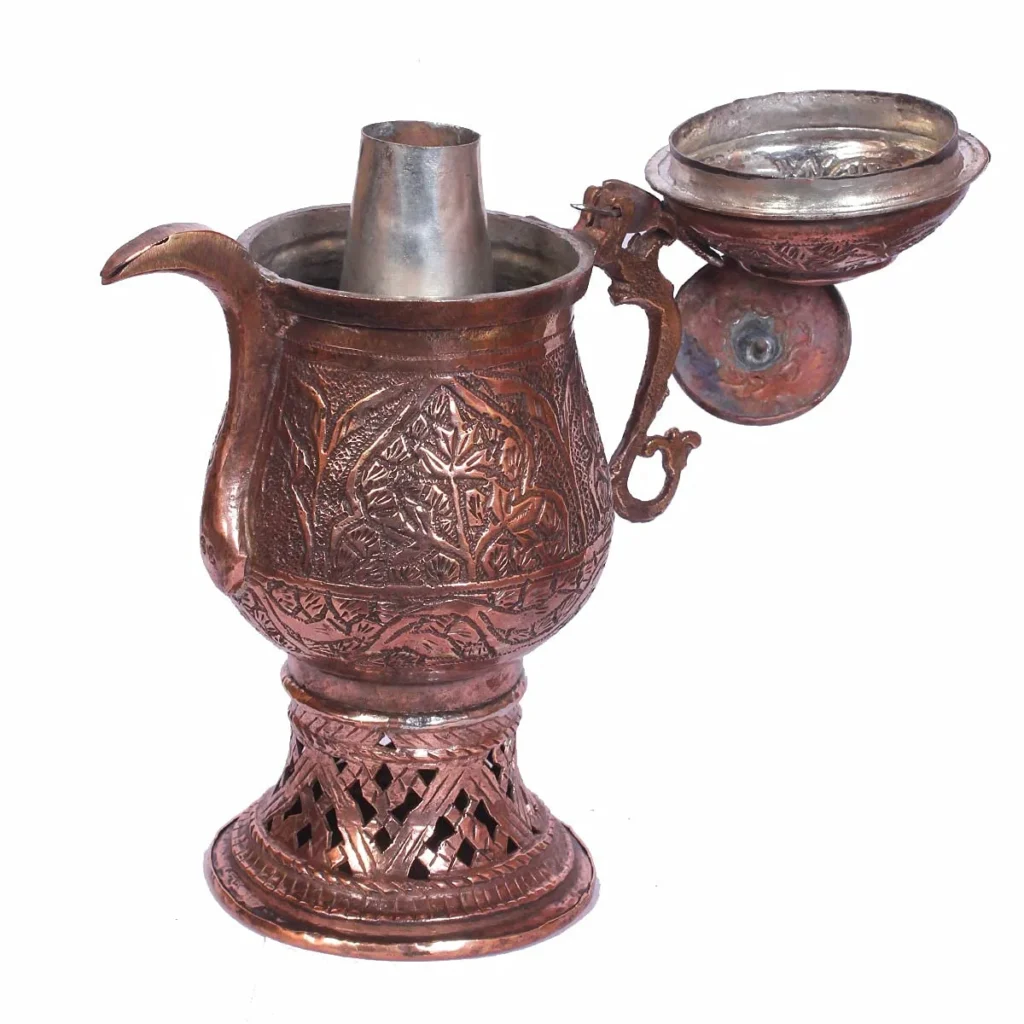
photo/amazonindia
The Meticulous Process
Like Noor, who perfected his craft one stroke at a time, Kashmiri copperware is crafted through a collaborative process involving many artisans, each specializing in their own technique. The Khar, the smith who shapes the copper; the Naqash, the engraver who brings the piece to life with motifs; and the Roshangar, the polisher who adds the finishing touches—each plays a vital role.
These artisans often lived in neighborhoods named after their craft, such as Roshangar-Mohalla. They used tools like the Draz (hammer), Yandrewah (anvil), and Basta (compass) to create pieces that were not just functional, but works of art.
A True Cultural Confluence
Over the centuries, Kashmiri copperware became a symbol of cultural fusion. While the Indo-Persian forms and techniques were adopted, the ornamentation remained uniquely Kashmiri. The motifs, like the Chinar (maple leaf) and the Badam (almond), told stories of the valley’s natural beauty and its people’s deep connection to their land.
As Noor continued to shape his copper, he pondered the significance of each piece, much like how Kashmiri craftsmen before him must have reflected on their creations. Could his strokes one day make history, just as the strokes of craftsmen before him had?
The Timelessness of Kashmiri Copperware
Despite the changing times, Noor, like many coppersmiths before him, remains dedicated to the purity of his craft. He finds solace in the simple act of creating something with his hands—a timeless vessel that holds the weight of history and the promise of dreams yet to come. Noor’s journey, much like the journey of Kashmiri copperware, is a testament to the enduring power of craftsmanship. Just as Noor refines his strokes every day, he understands that greatness comes not from grand gestures, but from the quiet dedication to one’s craft.
Types of Kashmiri Copperware
There’s a wide variety of copperware in Kashmir, each serving a distinct purpose:
- Samovar: This traditional kettle, used to brew tea, is an essential part of Kashmiri households.
- Tasht-naar: A ceremonial water jug and basin used in important rituals.
- Lota: A simple yet elegant vessel used to store water.
- Cooking utensils: The famous wazwaan pots are crafted from copper, used to prepare the region’s iconic dishes.
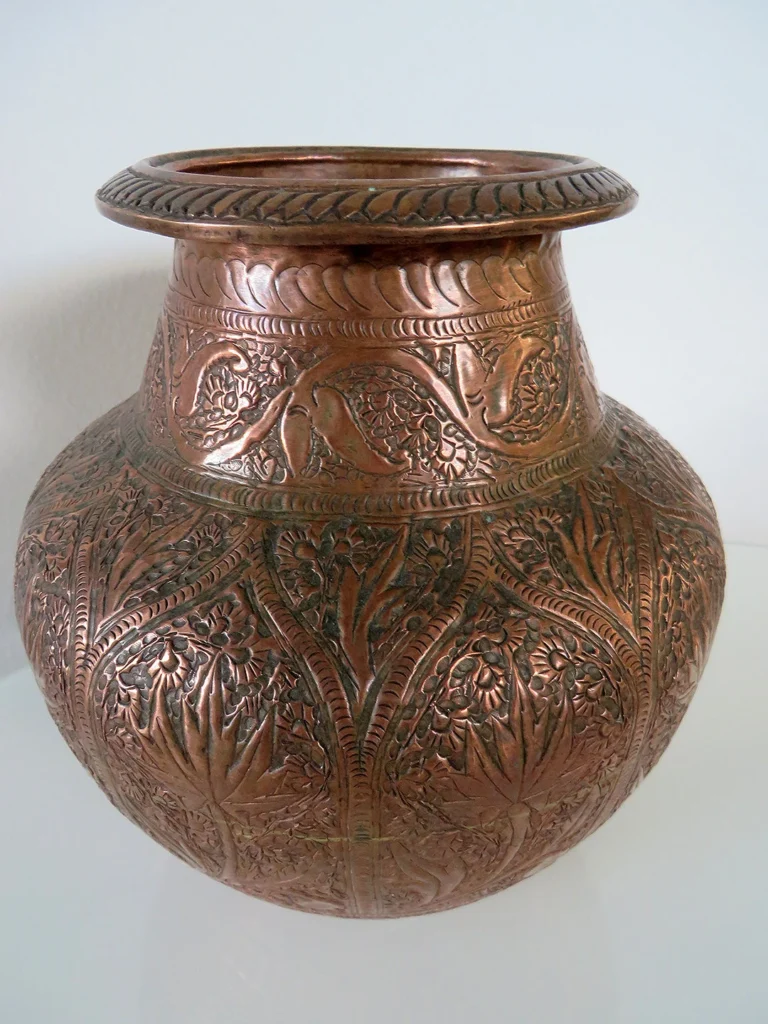
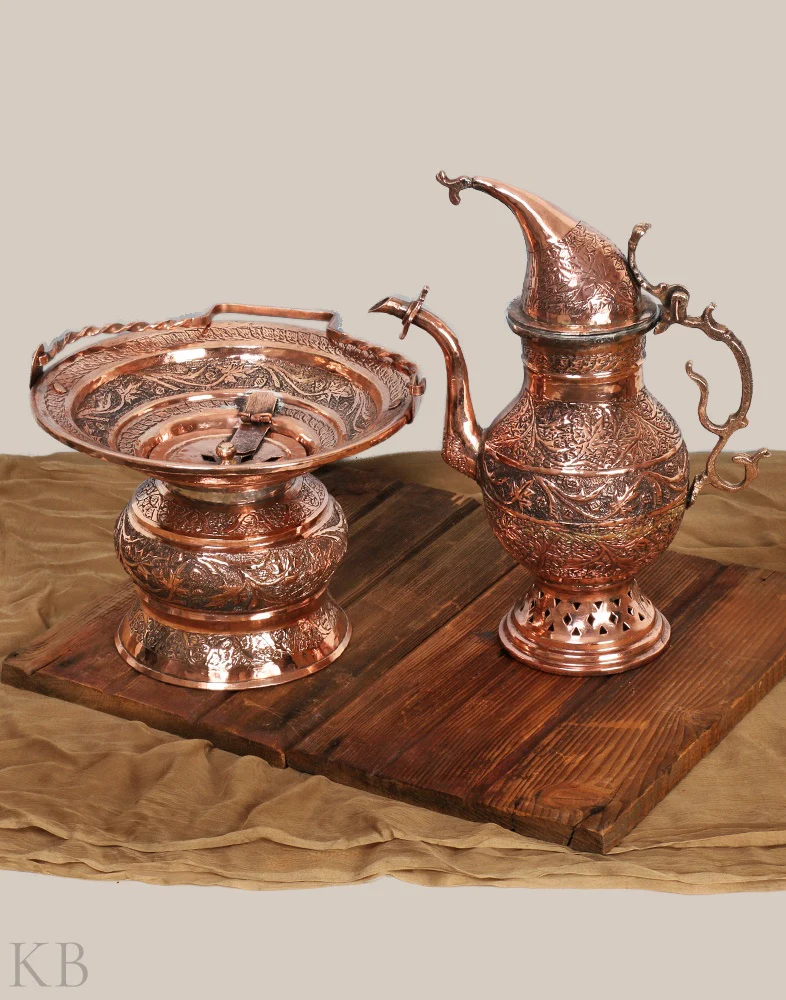
lota/photo/etsy/ Tasht-naar/photo/kashmirbox
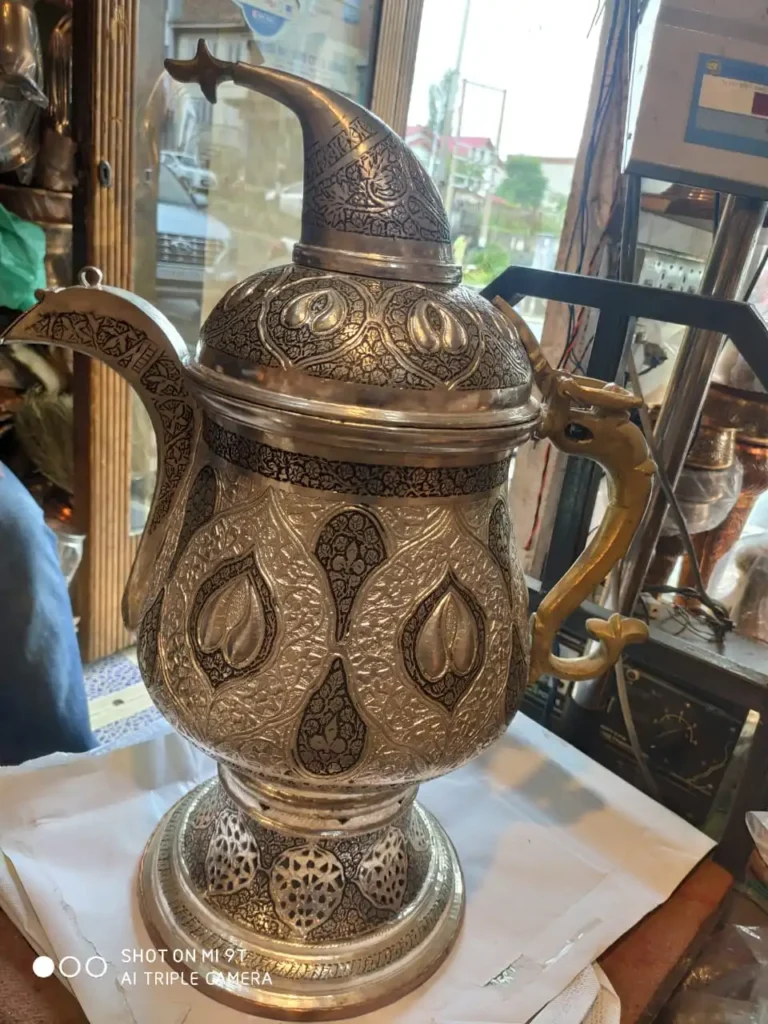
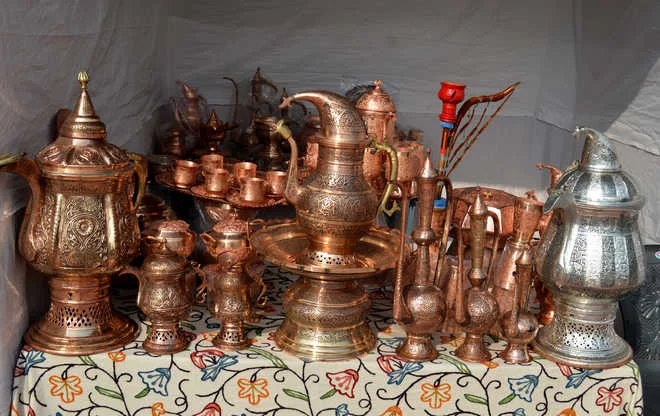
samovar/photo/kashmirwholesalebazar cooking utensils/photo/kashmirstore
The Art of Naqashi
Naqashi, or the engraving process, is where the magic happens. Using tiny chisels, Kashmiri artisans create intricate patterns that tell a story. Whether it’s delicate floral motifs or intricate calligraphy, each design holds cultural significance. These patterns are more than just decoration—they’re a celebration of Kashmiri identity.
The Cultural Significance of Copperware in Kashmiri Households
In Kashmir, copperware is more than just functional kitchenware. It’s a symbol of heritage, often passed down through generations as a family heirloom. These pieces hold deep emotional and cultural value, with families cherishing them not only for their beauty but also for the memories they carry.
From daily meals to important ceremonies, copperware plays a vital role in Kashmiri life. In weddings and religious rituals, copper items are often used, embodying purity and tradition. The emotional connection people have with copperware is hard to put into words—it’s like holding a piece of the past in your hands.
Challenges Facing Copperware Artisans Today
Despite the efforts to preserve and revive the craft, copperware artisans face significant challenges today.
Political Instability: The ongoing political instability in Kashmir poses another obstacle for the copperware industry. Frequent curfews, communication blackouts, and restrictions disrupt the artisans’ ability to work and sell their products, leaving the craft vulnerable.
Competition with Machine-Made Goods: The rise of machine-made alternatives has reduced demand for handmade copperware, which is more time-consuming and expensive to produce. This often results in lower income for artisans, many of whom struggle to make ends meet.
Rising Costs of Raw Materials: As copper is a finite resource, its price has steadily increased, putting a strain on artisans who rely on it for their livelihood. Imported copper and brass materials are also becoming more expensive due to changing economic conditions.
Lack of Young Apprentices: Fewer young people are learning the craft as the younger generation often seeks more lucrative job opportunities outside traditional craftsmanship. This has led to a shrinking pool of skilled artisans, putting the future of the craft in jeopardy.
Limited Access to Markets: While digital platforms have provided some opportunities for artisans to sell their products globally, many artisans in Kashmir still lack access to larger markets. Limited marketing skills and resources make it challenging for them to reach buyers outside the local area.
The Revival of Copperware Craft
The resurgence of copperware is part of a broader global trend toward sustainable living and a return to traditional, handmade goods. In the age of mass production, many consumers are drawn to items that have a story, something unique and made by hand—qualities that are inherent in Kashmiri copperware.
The increasing awareness of copper’s health benefits has also contributed to its renewed popularity. Copper’s ability to purify water, its antimicrobial properties, and its excellent heat conductivity make it a favorite for both home cooks and professional chefs alike.
Furthermore, copperware’s aesthetic appeal, with its warm tones and intricate designs, fits well with modern interior design trends, where there is a growing preference for incorporating natural and artisanal elements into living spaces.
Why Copperware is Gaining Popularity Again
Efforts to revive the traditional copperware craft in Kashmir have come from various fronts—government initiatives, artisan cooperatives, and private businesses working together to preserve this heritage. The revival has also been supported by design schools and non-profit organizations working with local artisans to modernize techniques while staying true to the roots of the craft.
One of the key drivers of this revival is the younger generation of artisans who are introducing new designs and processes while still honoring traditional methods. Modern technology is also being utilized in some workshops, making it easier to produce more intricate designs and higher-quality products, while social media and e-commerce platforms are providing artisans with a wider audience than ever before.
Copperware and Tourism in Kashmir
Kashmiri copperware is deeply intertwined with the region’s cultural identity, and it has become a focal point for tourists looking to take home a piece of the valley’s history. In markets like Srinagar’s famous Lal Chowk and Shah-e-Hamdan, tourists can find exquisitely crafted copper items ranging from household items to decorative pieces.
Many workshops in Kashmir welcome visitors to witness the artisans at work, where they can see the laborious process involved in creating a piece of copperware. This cultural tourism not only supports the artisans but also helps to keep the craft alive by educating tourists about its significance.
For many travelers, taking home a piece of Kashmiri copperware serves as a tangible memory of their time in the region, making copperware a popular souvenir and a representation of Kashmir’s rich heritage.
Sustainability and Eco-Friendliness of Copperware
Copperware is not only a beautiful addition to your home but also a sustainable choice. Copper is a highly recyclable material that can be reused without losing its properties, making it an eco-friendly alternative to plastic or other non-biodegradable materials. This longevity makes copperware a more responsible option for those looking to reduce their carbon footprint.
In addition, copper has natural antimicrobial properties, making it an excellent choice for food storage and serving, as it can kill bacteria and other microbes. In an age where sustainability and health are increasingly important, copperware offers a solution that is both environmentally and health-conscious.
Tips for Caring for Your Copperware
Copper, while beautiful, requires proper care to maintain its shine and functionality over time. Here are some practical tips for ensuring your copperware remains in great condition:
Lining for Cooking: If you’re using copperware for cooking, ensure that it’s lined with tin or stainless steel, as raw copper can react with acidic foods, potentially affecting both the taste and safety of the dish.
Cleaning with Natural Agents: Use natural ingredients like lemon and salt to clean tarnished copper. Rub the lemon or lime juice on the surface, sprinkle a little salt, and gently scrub with a soft cloth or sponge. This will restore its shine without damaging the material.
Avoid Abrasive Cleaners: Harsh, abrasive cleaners can scratch the copper surface and ruin the engraved designs. Always use a soft cloth or non-abrasive sponge.
Regular Polishing: Over time, copper develops a natural patina. While some people love the aged look, if you prefer the bright, shiny appearance of new copperware, regular polishing with a copper-specific polish is key.
Storage: To avoid unnecessary tarnishing, store copper items in a cool, dry place. You can also wrap them in a soft cloth to protect them from scratches.
Modern Interpretations of Traditional Copperware
In recent years, traditional Kashmiri copperware has seen a revival, not just as a relic of the past but as a contemporary art form that blends historical craftsmanship with modern aesthetics. Designers and artisans have begun experimenting with traditional forms and motifs while incorporating modern design elements to appeal to a broader audience. This shift includes creating sleek, minimalist copperware pieces, often tailored to meet the tastes of today’s urban consumers, blending utility with elegance.
One of the more popular modern adaptations is the Samovar, which is now designed in various sizes and adorned with new-age motifs while maintaining its original charm. Copper kitchenware is also seeing a resurgence in high-end restaurants, where chefs prefer using copper for its excellent heat conductivity and rustic appeal. Additionally, decorative copper pieces such as lamps, trays, and wall art have been reinvented to fit contemporary interiors, giving a modern twist to an age-old craft.
Conclusion
Kashmiri copperware is more than just a craft—it’s a living legacy that bridges the past and present. The intricate designs and timeless appeal of these pieces remind us of the beauty of tradition. By preserving this craft, we ensure that future generations can continue to appreciate the artistry and cultural significance of Kashmiri copperware.
FAQs
- What makes Kashmiri copperware different from other copper crafts?
The intricate Naqashi engraving process and the cultural significance attached to each piece set Kashmiri copperware apart from others. - Is cooking with copperware safe?
Yes, but it’s recommended to use copper cookware lined with tin or stainless steel to prevent copper from reacting with acidic foods. - Can copperware be used for decorative purposes?
Absolutely! Many people use Kashmiri copperware as decorative items due to its stunning designs. - How can I ensure my copperware stays in good condition?
Regular cleaning and polishing can help maintain the shine and prevent tarnishing. Use natural cleaners like lemon and salt for the best results. - Where can I buy authentic Kashmiri copperware?
Authentic Kashmiri copperware can be found in local markets in Kashmir or through trusted online artisans specializing in traditional crafts.
One thought on “India-Kashmir: The Timeless Beauty of Copperware Craft”